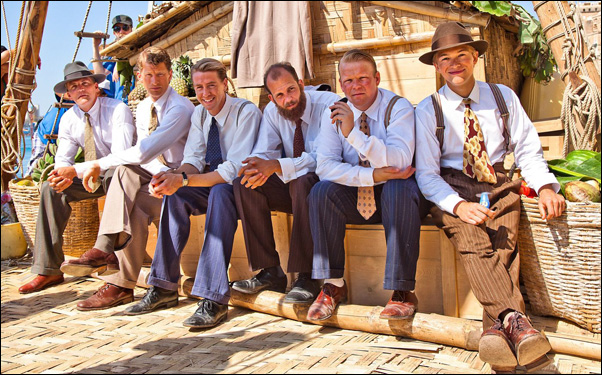It would be giving too much credit to the filmmakers of “Kon-Tiki” not to acknowledge that at least a small percentage of the film’s fun lies in the fact that in an era where the adventure genre has been all but abandoned, a ripping yarn of globetrotting derring do is unfortunately uncommon. However, taking a cue from its main subject Thor Heyerdahl (played in the film by Pal Sverre Hagen), the Norwegian explorer and scientist who set sail across the Pacific Ocean with a crew of five on a raft consisting of balsa wood and twine, “Kon-Tiki” is just crazy enough to work.
Directors Joachim Roenning and Espen Sandberg have substantially more resources at their fingertips than Heyerdahl’s crew, though in terms of a story to draw on, “Kon-Tiki” is nearly as flimsy as the adventurer’s watercraft. As related by the film, it was Heyerdahl’s belief that Peruvians, not Asians as had long been believed, populated Polynesia first, that led him to upend his marriage with two sons at home in Lillehammer and undertake such a treacherous voyage, a quest in which he has little personally invested in other than the fact his curiosity was sparked by a visit to Polynesia on his honeymoon.
Heyerdahl’s modest aim at such a high cost is a bit of a double-edged sword for the filmmakers since within the film, the expressions of similar concern amongst potential investors in Heyerdahl’s travels is used to incite the explorer to go it alone, but it also doesn’t seem like much to hang a two-hour feature on. However, the filmmakers, who previously gave a jolt of energy to another bold Norwegian legend in the 2008 war drama “Max Manus,” are more than capable of diverting your attention away from the goal of the expedition to the thrilling journey of actually getting there, armed with a boatload of special effect-enhanced set-pieces ranging from massive tidal waves to unexpected shark attacks that keep the energy up during Heyerdahl’s 101-day odyssey.
For a film rooted in history such as this, the inclusion of such shamelessly crowdpleasing elements constantly threaten to take away from its authenticity, particularly when one can compare the film to Heyerdahl’s own films of his exploits, which were culled together for the 1950 Oscar winning documentary also titled “Kon-Tiki.” Yet this “Kon-Tiki” appears to be hewing closer to the spirit of Heyerdahl rather than the reality he actually lived, yielding a heightened world full of eye-popping colors and grand locales, whether it’s an obviously European-tinged New York nightscape of the 1940s or the endless blue sea under starry skies, that no doubt he, not to mention audiences, would be happy to crawl inside. (As prominent as the special effects are, the fact that “Kon-Tiki” was ambitious enough to film in six different countries is equally noticeable.)
A triumphant score from Johan Soderqvist and Geir Hartly Andreassen’s lush cinematography reinforce the scale and scope of what Roenning and Sandberg are after, a creation of a larger-than-life tale that may render the film’s actors playing largely to types, but doing so more than competently. Sverre Hagen, with his matinee idol blue eyes and blindingly blond hair, plays Heyerdahl with a boyish enthusiasm that’s infectious and his supporting crew are allowed enough small moments to make an impression, with only Anders Baasmo Christiansen occasionally drifting overboard as Heyerdahl’s right-hand engineer who tends to the raft’s construction. Incidentally, it’s also the small moments between Heyerdahl and his wife (“Happy Happy” star Agnes Kittelsen) that may be the most emotionally resonant, a relationship that’s conveyed in just a few brief scenes over the phone but eventually become the film’s backbone. As the rest of “Kon-Tiki” suggests, it’s often the tiny things that lead to the greatest impact.
“Kon-Tiki” does not yet have U.S. distribution. It plays at the Toronto Film Festival twice more on September 8th at the Cineplex Yonge & Dundas 6 and September 14th at the Bloor Hot Docs Cinema.




